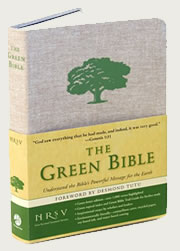How Green Is My Bible?
I first heard about The Green Bible several months ago, when I received a sampler. I admit to some cynicism. Publishers aren’t above capitalizing on the environmental movement by aiming for an altogether different kind of green, the almighty dollar. I fretted that this would become just another accessory to an earthy-crunchy lifestyle—something to blithely slip into those fair-trade multiple-use canvas bags en route to the organic farmer’s market—not for actual reading, mind you, but to have on hand to enhance one's ecological street cred. Did the world really need another niche Bible? Especially one called The Green Bible, a title already used fifteen years ago for a similar product from Orbis Books? I didn’t think so.
It appears I was wrong. The new Green Bible is actually pretty special. In an ironic twist on the red-letter Bibles that fundamentalist Christians have used in the past, this Bible has all passages on creation care, environmentalism, or the earth in green type. Admittedly, some of these verses are a stretch, but it’s surprising how many are relevant to ecology. For example, I came across this punch-in-the-stomach passage in Jeremiah that feels entirely different when considered in light of creation care:
How long will the grass mourn, and the grass of every field wither?
For the wickedness of those who live in it
The animals and the birds are swept away;
And because people said, “He is blind to our ways.” (Jer. 12:4)
In Jeremiah and throughout the Bible, especially the prophets, we see a connection between spiritual desolation and a wasted landscape. The Green Bible makes it verdantly, depressingly clear that the Bible assumes explicit connections between God’s blessings and an abundant earth.
The Green Bible brings together a host of outstanding contributors for the front matter, with essays by Brian McLaren, Barbara Brown Taylor, Desmond Tutu, and my favorite contribution by New Testament scholar N.T. Wright. (“Jesus is coming,” he says. “Plant a tree!”) Several people muse on the import of Adam being created from adamah, or ground/earth, while James Jones takes it a step further by exploring the significance of Jesus being the Son of Man—which, when rendered in Hebrew, is ben adam, or Son of the Earth. How might our understanding of Jesus change when we consider the passages where Jesus calls himself Son of Man and also makes reference to the earth? Intriguing.
That’s not to say that The Green Bible is perfect. Just as the liberal Christians who are the target market for such a Bible accuse their fundamentalist counterparts of prooftexting and taking passages out of context, The Green Bible is a liberal prooftexter’s dream. This becomes a bit embarrassing when we look at the way the version completely ignores all of the decidedly non-environmental passages the Bible has to offer, such as those on animal sacrifice or laying waste to the land of one’s enemies. None of those passages gets the green stamp of approval. The green-letter prooftexting also doesn’t solve the problem of taking verses out of context: in the whole Book of Ruth, which is decidedly environmental in theme, there is not one highlighted green passage. Could we at least have a sidebar on the biblical practices of gleaning and caring for the poor? We are losing the forest for the literal trees.
The ultimate question is whether it is worth it to pay thirty bucks for The Green Bible. Though flawed, it is fascinating. It has a guided “trail” of environmental references for readers who want to use it as a study guide to what God might have to say about creation care. It has a terrific index to “green subjects” and is beautifully packaged using soy ink, a cotton/linen cover, and ten percent recycled paper.
Bottom line: Even if you don’t purchase it, it’s worth checking it out from the local library. More environmental, too.
Copyright © 2008 Jana Riess.
